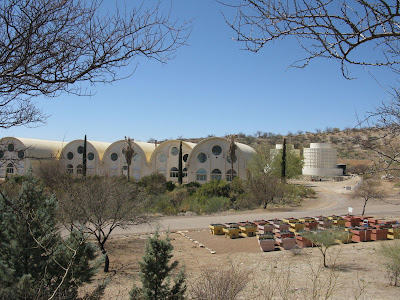



Just slightly north east of Tucson Arizona near Oracle is Biosphere 2 which calls its self the largest green house in the world. While indeed the facility is pretty amazing I was surprised to discover that the facility was not equipped with elevators (except the one to go view the sea project) to allow access to handicapped persons to view the facility.



The Biosphere 2 covers 3.4 acres and is 91 feet high at the highest part. It is sealed from the earth below by a 500 ton welded stainless steel liner and from the sky above by 7,200,000 cubic feet of sealed glass. It remains the largest closed system ever created.
The human experiment was conducted from 1991 to 1993. Eight individuals were sealed in the Biosphere with only two months of supplies at which time their crops were supposed to have been matured.
The agricultural system produced 83% of the total diet and some of the crops included bananas, papayas, sweet potatoes, beets, peanuts, lablab and cowpea beans, rice and wheat. During the first year the crew was hungry as it was an El Nino year and received less than the normal amount of sunlight which effected the crop yield.
They also had 35 hens and 3 roosters, 5 goats which they used for milk (they only ended up having about one ounce of milk per day). They also had 2 sows and one boar pig as well as tilapia fish. They had only about one meat meal every two weeks.
Biosphere 2 suffered from wildly fluctuating levels of CO2 levels which resulted in most of the vertebrates and all of the pollinating insects dying.
During the human experiment oxygen levels which began at 20.9% fell to the dangerously low level of 14.5%. The crew became unable to concentrate or answer questions rationally. The medical team decided to boost the oxygen levels by injections.


This was the crew's private living quarters.


This is the crews dining room.



This is the kitchen which was equipped with every modern convenience. The menu was built around rice, beans, wheat, sorghum, sweet potatoes, beets and peanuts. The only sweetness that the crew had came from bananas, papayas, and other fruits.
The crew had to learn to cook without oil and limited ingredients and each crew member took on the cooking duties for the group every eight days.


This is the rain forest section which started out with approximately 300 different species of plants. Only about 100 species still live here today.



This is part of the ocean project. It is amazing to see this lush paradise with the Arizona desert as a back drop.


This the savanna grassy area.


This is the desert area which was just starting to awaken from its winter slumber. A few flowers were beginning to bloom and some of the shrubs were starting to bud.



We then went down to the mechanical section of the operation. As with most things what goes on underground is even more intricate that the above ground operation.



The Biosphere has two lungs or variable air-volume control devices. The purpose of these lungs are to create an area for the air that is expanded from the heat of the days sun to go and to allow the air to return when the night time cooling and contraction occurs. The heated air is forced down tunnels and pushes a circular plate which is attached to the ceiling by black membranes upward. When the air cools and contracts the plate which is attached to the black membranes lowers forcing the air back up the tunnels. Without these lungs the expanded air would have no where to go and may cause the Biosphere to explode.



This is the lung from the outside.


This is just as we were exiting the lung.


This is the energy center. Inside the five arches are two large generators. the primary generator uses natural gas for fuel and the second uses diesel. There are also boilers to heat water and chillers to cool water. The large towers to the right are used to cool air by drawing air across a column of water. This power center is just used to mainain power during the frequent power outages during the monsoon season in summer.
















